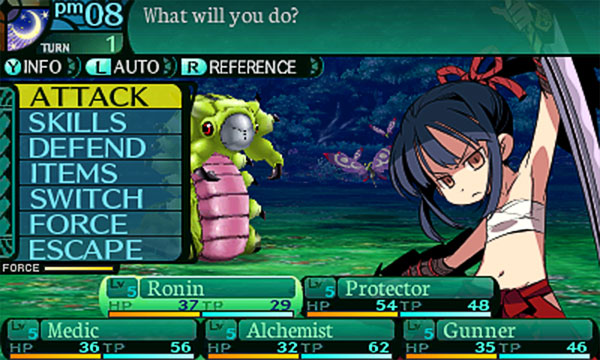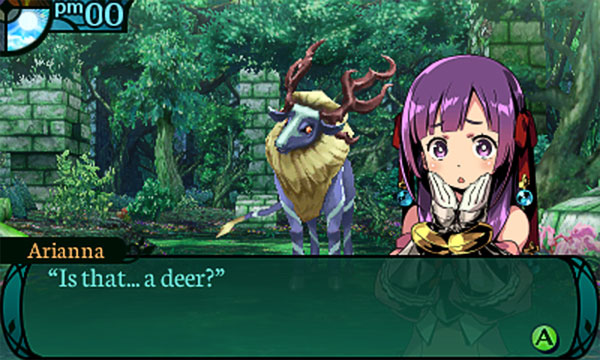Satisfying exploration; two distinct campaigns; enjoyable (if cliche) narrative; adjustable difficulty setting
Lacks the variety of other installments; gameplay can be daunting, especially for newcomers
My first brush with death came at the hands– or, rather, hooves– of a giant deer. My guildmates and I had spent the better part of the week charting the first stratum of the Yggdrasil Labyrinth, the sprawling natural maze located just outside the walls of High Lagaard, and had begun to fancy ourselves seasoned explorers. We slinked past the raptors patrolling the forest’s second and third floors without much difficulty. We managed to avoid the giant bats flitting around the dungeon’s fourth floor. We even rescued an injured band of soldiers after they had been ambushed by a ferocious monster. With all of these achievements under our collective belts, we were confident that we could handle any obstacle the Labyrinth threw at us.
As it turns out, we were gravely mistaken. From the moment we crossed paths with the deer, it was obvious we were still outmatched by the forest’s lowliest boss. Before we could even prepare our defenses, the monster pounced, landing a near-fatal blow on Arianna, the princess we were charged with protecting. Our War Magus rushed to her aid, but she, too, quickly fell to the deer’s attacks. Even our battle-hardened Protector was stricken with panic at the sight of the monster and blindly lashed out at friend and beast alike. Wounded and on the verge of defeat, we retreated to town– alive, but greatly humbled. The Labyrinth taught us a valuable lesson that day.
Preparation and caution are the two greatest tools for survival in Etrian Odyssey 2 Untold: The Farnir Knight, the latest dungeon crawler from Atlus. Like the first Etrian Odyssey Untold game, Fafnir Knight is not a new adventure, but a remake/reimagining of one of the series’ previous installments. As such, the title features two separate campaigns for players to embark on: Classic mode, a recreation of the main quest from Etrian Odyssey II: Heroes of Lagaard, and Story mode, a more narrative-driven version of the same journey. Both campaigns take players through the same dungeons (though Story mode also features a second, smaller labyrinth that you’ll be revisiting throughout the course of the game), but the experience differs fairly dramatically depending upon which mode you play through.

Series purists will likely prefer the greater freedom of Classic mode, which allows you to create and customize your own characters, but newcomers will be drawn to the Story mode. Here, players are placed in the role of the nameless Fafnir Knight, a young warrior raised by the Midgard Library. Together with your childhood friend Flavio, you’re charged with escorting the Princess of Caledonia on her quest to complete her kingdom’s centennial ritual, which ultimately becomes entwined with preventing an ancient catastrophe. The narrative itself is fairly generic, adhering to the usual RPG tropes, but the party members you meet along the way are all likeable, and it does a much better job of framing the adventure with a sense of purpose than Classic mode.
Regardless of which campaign you choose, your mission remains largely the same: explore the winding depths of the Yggdrasil Labyrinth and find the mythical city fabled to rest in its branches. As in past Etrian Odyssey games, you’ll be spending the vast majority of the adventure clawing your way through the dungeon’s many floors, battling enemies, charting out your progress, farming materials, and avoiding the infamously overpowered FOEs that stalk its corridors. Fafnir Knight does little to build upon this formula, but the game is still just as enjoyable as previous titles thanks to the series’ distinctive mechanics, which set it apart from other role-playing games on 3DS.
The most notable of these is the cartography system. Rather than giving you a map of the Labyrinth at the start of your journey, Fafnir Knight tasks you with charting out the dungeon manually as you explore it, using the handheld’s touch screen as a makeshift piece of graph paper. This instills the entire adventure with a palpable sense of discovery, as you never know what you’ll find each time you set foot in an unexplored area. Every new stratum you come upon is a mystery that beckons to be solved, and the sense of satisfaction you feel when you complete another map and access a new floor is immense. (The game also includes the option to automatically chart the Labyrinth while you play, though this robs the adventure of much of its appeal.)
Likewise, exploration rarely feels monotonous thanks to the series’ signature FOEs. Unlike the typical monsters that beset you randomly during your journey, FOEs are boss-like creatures that visibly patrol the map. These beasts are far more powerful than your party the first time you encounter them, and your only hope for survival is to simply avoid them. This leads to some very tense puzzle solving, as you’ll need to make note of their movement patterns and figure out how to slip past them undetected. The game also introduces new types of FOEs fairly frequently, each of which requires a unique strategy to avoid, keeping the adventure fresh and engaging.

As enjoyable as the game can be, however, Fafnir Knight still won’t appeal to everyone. By their very nature, dungeon crawlers are a demanding strain of RPGs, and Etrian Odyssey especially conforms to some of the genre’s more off-putting tendencies. The game unfolds at a very deliberate pace; your progress through the Labyrinth is incremental, and you’ll need to frequently return to town to patch up wounds and sell off any materials you have collected before continuing your trek through the dungeon. Fortunately, Fafnir Knight retains the adjustable difficulty setting introduced in Etrian Odyssey IV, allowing you to tweak the challenge level at any point if you ever find yourself faced with a seemingly insurmountable obstacle, but the game can still be quite daunting, even on an easier setting.
Fafnir Knight also feels a bit basic compared to some of the series’ more recent installments, as it lacks some of the features that have defined later adventures. This isn’t much of a surprise given the fact that it is based on the second title in the franchise, but their absence is nevertheless noticeable. In particular, the overworld from Etrian Odyssey IV is greatly missed, as it provided a respite from the constant grind of dungeon crawling and injected the game with some needed variety.
Ultimately, Etrian Odyssey 2 Untold: The Fafnir Knight is another satisfying dungeon crawler from Atlus, though whether it is worth exploring depends on your standing with the series. Fans who’d like to experience a traditional Etrian Odyssey game would be better served starting with Etrian Odyssey IV, as it offers the most compelling adventure of any main installment. However, if you’ve been put off by the series’ lack of narrative, the Story mode in Fafnir Knight does a nice job of pushing the adventure forward without diluting the experience. It’s true the Etrian Odyssey series may still be an acquired taste for most gamers, but thanks to Fafnir Knight’s stronger tale and adjustable difficulty, Atlus has done an admirable job of making it more palatable to a wider audience.
Nintendojo was provided a copy of this game for review by a third party, though that does not affect our recommendation. For every review, Nintendojo uses a standard criteria.




 ShareThis
ShareThis






